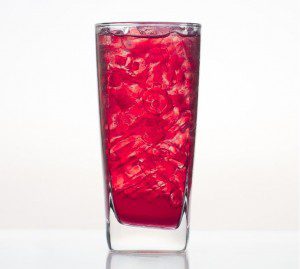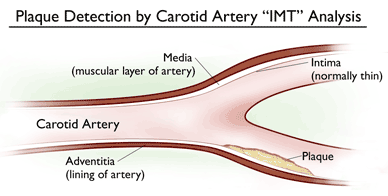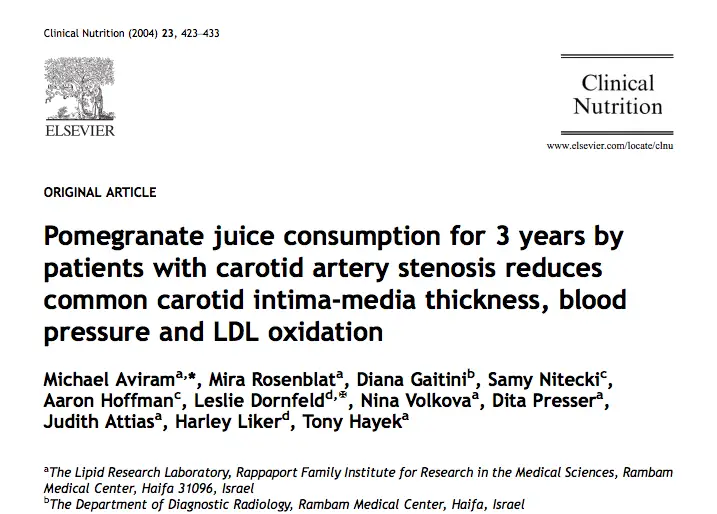By Sayer Ji
Contributing Writer for Wake Up World
Millions of people take toxic cholesterol and blood pressure lowering drugs that may do nothing to reduce heart disease specific mortality. Pomegranate juice, on the other hand, actually reverses underlying pathologies of the cardiovascular system that lead to bypass surgeries and heart attacks.
One of the most amazing clinical studies ever performed has been hidden away behind a pay wall for over a decade. When I first stumbled upon this clinical pearl two years ago, in the form of the publicly indexed abstract on pubmed.gov, my jaw nearly dropped. I’ve finally acquired the full version of the study and am now excited to report on its implications in greater depth to help raise awareness about the power of pomegranate to heal the body, and I believe, save millions lives from premature death from heart disease.
The most eye-opening line in the abstract reveals why our original report on the study, How To Clean Your Arteries With One Simple Fruit, was so well received: “Pomegranate juice consumption resulted in a significant IMT [intima media thickness] reduction, by up to 30%, after 1 year.”
[pro_ad_display_adzone id=”110028″]
We shouldn’t be that surprised at how great an interest there is among the masses in safe, delicious, and affordable drug alternatives that have the power to unclog arteries? Certainly the drugs aren’t working, with the most popular class — cholesterol-lowering statins — being linked to over 300 adverse health effects. But sometimes the technical language of medicine gets confusing: what does this pomegranate-induced reduction in the intima media thickness (IMT) of the arteries mean?
Reducing The Intima Media Thickness: Reversing Atherosclerosis
The intima media is the middle portion of the arteries that become inflamed and fill up with plaque comprised of oxidized fats, immune cells, and their debris, in the condition known colloquially as “blocked arteries.” As the intima media grows thicker, less space is available for the blood contents to move through the opening (lumen) of the arteries. When the arteries eventually close or are blocked, catastrophic injury or death may follow. Therefore, anything that can safely reduce, or better, reverse intima media thickening is the holy grail as far as obtaining a root cause resolution of atherosclerosis, and by implication would profoundly reduce deaths linked to cardiovascular mortality.
Indeed, in a world where the #1 cause of death is cardiovascular disease, and where we preemptively medicate millions more with drugs that only reduce surrogate markers for cardiovascular disease risk – i.e. lipoproteins carrying cholesterol – without showing any convincing evidence that it is reducing cardiovascular disease or all-cause mortality, how could something as simple and powerful as pomegranate be overlooked? In fact, if a simple daily dietary intervention is capable of regressing and/or reversing the underlying disease process in millions of fatal cardiac cases, it would seem highly unethical not to use it.
Here, we wish to bring some of the finer details of this clinical trial to light, to further substantiate the value of botanical and food-based interventions not only in preventing but treating major chronic disease processes like cardiovascular disease, the developed world’s most deadly disease.
The Pomegranate “Artery Cleaning” Clinical Trial
Published in Clinical Nutrition in 2014 and titled, “Pomegranate juice consumption for 3 years by patients with carotid artery stenosis reduces common carotid intima-media thickness, blood pressure and LDL oxidation,” Israeli researchers discovered pomegranate, administered in juice form over the course of a year, reversed plaque accumulation in the carotid arteries of patients with severe, though symptomless, carotid artery stenosis (defined as 70–90% blockage in the internal carotid arteries).
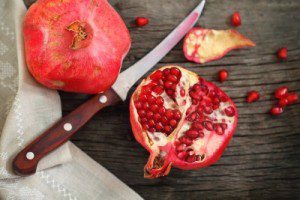 The study consisted of nineteen patients, 5 women and 14 men, aged 65-75, non-smokers. They were randomized to receive either pomegranate juice or placebo. Ten patients were in the pomegranate juice treatment group and 9 patients that did not consume pomegranate juice were in the control group. Both groups were matched with similar blood lipid and glucose concentrations, blood pressure, and with similar medication regimens which consisted of blood-pressure lowering (e.g. ACE inhibitors, β-blockers, or calcium channel blockers) and lipid lowering drugs (e.g. statins).
The study consisted of nineteen patients, 5 women and 14 men, aged 65-75, non-smokers. They were randomized to receive either pomegranate juice or placebo. Ten patients were in the pomegranate juice treatment group and 9 patients that did not consume pomegranate juice were in the control group. Both groups were matched with similar blood lipid and glucose concentrations, blood pressure, and with similar medication regimens which consisted of blood-pressure lowering (e.g. ACE inhibitors, β-blockers, or calcium channel blockers) and lipid lowering drugs (e.g. statins).
The ten patients in the treatment group group received 1.69 ounces (50 ml) of pomegranate juice per day (about the volume of a shot glass), which contained .036 milligrams of total polyphenols (primarily tannins and anthocyanins), for a period of 1 year, and five out of them agreed to continue for up to 3 years.
The remarkable results were reported as follows:
“The mean intima media thickness the left and right common carotid arteries in severe carotid artery stenosis patients that consumed pomegranate juice for up to 1 year was reduced after 3, 6, 9 and 12 months of pomegranate juice consumption by 13%, 22%, 26% and 35%, respectively, in comparison to baseline values.”
You can only imagine what would happen if a pharmaceutical drug was shown to reverse plaque build up in the carotid arteries by 13% in just 3 months! This drug would be lauded the life-saving miracle drug, and not only would be promoted and sold successfully as a multi-billion dollar blockbuster, but discussion would inevitably follow as to why it should be mandated.
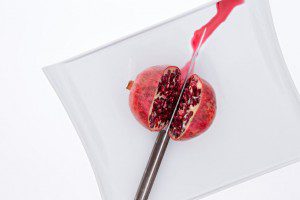 While these results are impressive, if not altogether groundbreaking for the field of cardiology, they may be even better than revealed in the stated therapeutic outcomes above. When one factors in that the carotid artery stenosis increased 9% within 1 year in the control group, the pomegranate intervention group may have seen even better results than indicated by the measured regression in intima media thickness alone. That is, if we assume that the pomegranate group had received no treatment, the thickening of their carotid arteries would have continued to progress like the control group at a rate of 9% a year, i.e. 18% within 2 years, 27% within 3 years. This could be interpreted to mean that after 3 years of pomegranate treatment, for instance, the thickening of the arteries would have been reduced over 60% beyond what would have occurred had the natural progression of the disease been allowed to continue unabated.
While these results are impressive, if not altogether groundbreaking for the field of cardiology, they may be even better than revealed in the stated therapeutic outcomes above. When one factors in that the carotid artery stenosis increased 9% within 1 year in the control group, the pomegranate intervention group may have seen even better results than indicated by the measured regression in intima media thickness alone. That is, if we assume that the pomegranate group had received no treatment, the thickening of their carotid arteries would have continued to progress like the control group at a rate of 9% a year, i.e. 18% within 2 years, 27% within 3 years. This could be interpreted to mean that after 3 years of pomegranate treatment, for instance, the thickening of the arteries would have been reduced over 60% beyond what would have occurred had the natural progression of the disease been allowed to continue unabated.
3 Ways Pomegranate Heals The Cardiovascular System
The researchers identified three likely mechanisms of action behind pomegranate’s observed anti-atherosclerotic activity:
Antioxidant properties:
Subjects receiving pomegranate saw significant reductions in oxidative stress, including decreases in autoantibodies formed against ox-LDL, a form of oxidized low density lipoprotein associated with the pathological process of atherosclerosis. Decreases in oxidative stress were measurable by an increase in the blood serum enzyme paraoxonase 1 (PON1) of up to 91% after 3 years; PON1 is an enzyme whose heightened activity is associated with lower oxidative stress.
All of this is highly relevant to the question of pomegranate’s anti-atherosclerotic activity because of something called the lipid peroxidation hypothesis of atherosclerosis, which assumes that it is the quality of the blood lipids (i.e. whether they are oxidized/damaged or not), and not their quantity alone that determine their cardiotoxicity/atherogenicity. Essentially, pomegranate prevents the heart disease promoting effects of oxidative stress.
Blood Pressure Lowering Properties:
The intervention resulted in significant improvement in blood pressure: the patient’s systolic blood pressure was reduced 7%, 11% ,10%, 10% and 12% after 1, 3, 6, 9, and 12 months of pomegranate consumption, respectively, compared to values obtained before treatment. Pomegranate’s ability to reduce systolic blood pressure indicates it has a healing effect on the endothelium, or the inner lining of the artery which fails to relax fully in heart disease; a condition known as endothelial dysfunction.
Plaque Lesion Stabilization:
Because two of the ten patients on PJ (after 3 and 12 months) experienced clinical deterioration, carotid surgery was performed and the lesions were analyzed to determine the difference in their composition to those who did not receive pomegranate.
The researchers noticed four distinct positive differences in the composition of the pomegranate-treated lesions:
- Reduced Cholesterol Content: “The cholesterol content in carotid lesions from the two patients that consumed PJ was lower by 58% and 20%, respectively, in comparison to lesions obtained from CAS patients that did not consume PJ (Fig. 3A).”
- Reduced Lipid Peroxides: “[T]he lipid peroxides content in lesions obtained from the patients after PJ consumption for 3 or 12 months was significantly reduced by 61% or 44%, respectively, as compared to lesions from patients that did not consume PJ (Fig. 3B).
- Increased Reduced Glutathione Content: “A substantial increase in the lesion reduced glutathione (GSH) content, (GSH is a major cellular antioxidant) by 2.5-fold, was observed after PJ consumption for 3 or 12 months, (Fig. 3C).
- Reduced LDL Oxidation: “LDL oxidation by lesions derived from the patients after PJ consumption for 3 or 12 months, was significantly (Po0.01) decreased by 43% or 32%, respectively, in comparison to LDL oxidation rates obtained by lesions from CAS patients that did not consume PJ (Fig. 3D).”
Essentially these results reveal that not only does pomegranate reduce the lesion size in the carotid arteries, but “the lesion itself may be considered less atherogenic after PJ consumption, as its cholesterol and oxidized lipid content decreased, and since its ability to oxidize LDL was significantly reduced.”
This finding is quite revolutionary, as presently, the dangers of carotid artery stenosis are understood primarily through the lesion size and not by assessing for the quality of that lesion. This dovetails with the concept that the sheer quantity of lipoproteins (i.e. “cholesterol”) in the blood can not accurately reveal whether those lipoproteins are actually harmful (atherogenic); rather, if lipoproteins are oxidized (e.g. ox-LDL) they can be harmful (or representative of a more systemic bodily imbalance), whereas non-oxidized low density lipoprotein may be considered entirely benign, if not indispensable for cardiovascular and body wide health. Indeed, in this study the researchers found the pomegranate group had increased levels of triglycerides and very low density lipoprotein, again, underscoring that the anti-atherosclerotic properties likely have more to do with the improved quality of the physiological milieu within which all our lipoproteins operate than the number of them, in and of itself.
Finally, it should be pointed out that all the patients in this study were undergoing conventional, drug-based care for cardiovascular disease, e.g. cholesterol- and blood pressure-lowering agents. Not only did the pomegranate treatment not appear to interfere with their drugs, making it a suitable complementary/adjunct therapy for those on pharmaceuticals, but it should be pointed out that the control group’s condition got progressively worse (e.g. the mean IMT increased 9% within 1 year), speaking to just how ineffective drugs are, or how they may even contribute to the acceleration of the disease process itself.
Pomegranate’s 100+ Health Benefits
Believe it or not, pomegranate has many other ways in which it can help to heal the cardiovascular system, as well as other organ systems. The GreenMedInfo research project has identified over 100 distinct health benefits of pomegranate: View the Pomegranate Research Database here.
Further articles by Sayer Ji:
- Research: Plants Cure Cancer, Not Chemicals
- A Higher Level of Freedom – The Benefit of Cannabis to Health
- Eating Wheat & Cow’s Milk Disrupt DNA Expression & Antioxidant Status
- How WHOLE Turmeric Heals the Damaged Brain
- Fluoridated Water Can Calcify Arteries, Study Finds
- How Monsanto’s ‘RoundUp’ is Cursing the Global Food Supply
- Research Proving Vitamin C’s Therapeutic Value in 200+ Diseases
- Biophotons: The Human Body Emits, Communicates with, and is Made from Light
- 13 Evidence-Based Medicinal Properties of Coconut Oil
- The Ancient Flower That Heals The Human Soul
About the author:
Sayer Ji is an author, educator, Steering Committee Member of the Global GMO-Free Coalition (GGFC), advisory board member of the National Health Federation, and the founder of GreenMedInfo.com – an open access, evidence-based resource supporting natural and integrative modalities. His writings have been published and referenced widely in print and online, including Truthout, Mercola.com, The Journal of Gluten Sensitivity, New York Times and The Well Being Journal.
In 1995 Sayer received a BA degree in Philosophy from Rutgers University, where he studied under the American philosopher Dr. Bruce W. Wilshire, with a focus on the philosophy of science. In 1996, following residency at the Zen Mountain Monastery in upstate New York, he embarked on a 5 year journey of service as a counsellor-teacher and wilderness therapy specialist for various organizations that serve underprivileged and/or adjudicated populations. Since 2003, Sayer has served as a patient advocate and an educator and consultant for the natural health and wellness field.
Visit GreenMedInfo online and on Facebook, or sign up for GreenMedInfo’s e-Newsletter.
[pro_ad_display_adzone id=”110027″]

